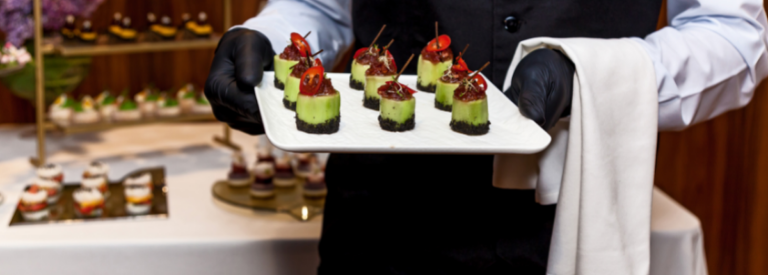Whether you're starting a food truck catering business or your restaurant is beginning to offer on-premise catering, it's essential to create a catering invoice for every event. The catering invoice is a document used to charge clients for the variety of services you'll provide at the event. While creating an invoice sounds like a daunting task, we're here to help. Follow our guide on how to create a catering invoice.
Why Are Catering Invoices Important?
 A catering company sends an invoice to a client once they've
agreed on the services for an event. The invoice provides clients and
businesses with a summary of the payment terms, service details, time,
and other important information. Sending an invoice to your client is
important because it allows you to:
A catering company sends an invoice to a client once they've
agreed on the services for an event. The invoice provides clients and
businesses with a summary of the payment terms, service details, time,
and other important information. Sending an invoice to your client is
important because it allows you to:
- Maintain records: You can keep a legal record of the services and meals that your company will offer on the day of the social or corporate event. An invoice helps avoid miscommunication between you and your clients to ensure clients know what to expect. It also provides you with documentation of your business's financial history and track revenue.
- Protect your company: Invoices help protect your business from false lawsuits because they lay out the work you complete, payment terms, services offered, and other details you and clients agree on.
- Easily file taxes: Recording and safely storing all of your catering sales makes it painless to report your company's income.
- Analyze your business: You can track your clients' buying patterns, identify trends, popular meals, and the time of year your services are in high demand. Staying up-to-date on purchasing patterns will allow you to develop effective marketing strategies.
What Should My Catering Invoice Include?
Whether you're offering a plated dinner at a wedding or a staff-service buffet at a corporate event, your catering invoice needs to include specific details for the event. A detailed invoice provides clients with an overview of services and prices, allowing them to know what to expect at their event. The invoice also gives staff members working the event information on the location, time, and services. It's essential to include the following details in your catering invoice to remain organized and ensure you and your clients are on the same page.
Company Information
At the top of the invoice, you should include your company's name, address, phone number, fax, email, and website. Including your contact details ensures clients know how to get in touch with you if they have any questions.
Client Information
When speaking to your clients, ask them for their full name, email
address, phone number, and mailing address. Having their information
will allow you to send the invoice to the correct email or address and
guarantee the legality of the invoice.
Invoice Number
Each invoice you send must have a unique invoice number to distinguish it from the rest and ensure that you properly document your income for tax purposes. You can set invoice numbers in chronological order to make it easy to keep track of invoices by date. You can also assign each client a unique invoice number and add additional numerals to their number when they rehire you.
Invoice Date
When inputting the invoice date, it's important to add the date you sent out the invoice and not the date you created it. This way, if your payment terms require clients to pay their invoices in 20 days, they have exactly 20 days to complete the transaction.
Service Information
The service information section should include the venue name, location, telephone number, and other essential information your catering team may need for the event. If it's an off-premise event, you should also have the time of arrival and departure. This way, clients will understand how long you'll provide your service. To help keep track of your salespeoples' work, you should input the person's name responsible for arranging the catering services for the event.
Food & Services Ordered
It's vital to include the quantity of food and the type of services you
are offering at the event in the invoice. Your clients can confirm that
they are receiving everything they and the salespeople spoke about. This
will also let chefs know the amount of food they need to prepare.
Include all the information on the services you're offering so your
staff understands how many days or hours in advance they need to prepare
for the event.
Order Details
Depending on the catering service you're providing for a particular event, you may want to bill by quantity, hours, or a flat rate. Regardless of the types of services you're offering, you should provide clients with a complete breakdown of each service. Consider including the subtotal, sales tax, service fee, and other applicable charges for the event.
Personalized Note
Adding a customized note to your invoice will put a smile on your client's face and is an easy way to show your appreciation. You can add a message that says, "thank you for your business" or "looking forward to seeing you soon."
Terms & Conditions
The terms and conditions section includes all of your business's payment terms such as due dates and penalties for late payments. If you are sending the invoice to an international client, clarify the currency you're using to avoid confusion.
Create A Catering Invoice Today!
Sending catering invoices to clients is essential because it allows you to maintain record payments, analyze purchasing trends, protect your business from lawsuits, and more. While creating an invoice is challenging, follow our guide to easily create one.








